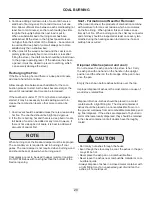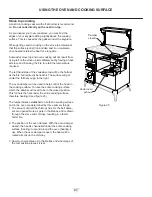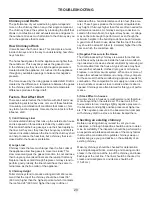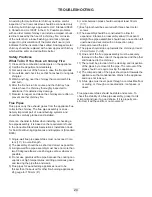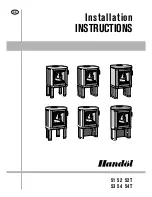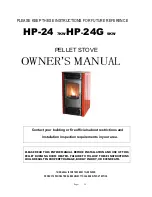
10
Clearance Reductions
There are many alternate decorative methods to reduce
clearances to combustible materials. See your dealer,
or local fire or building official to assure the appropriate
standards are being met with these alternatives. In Canada,
refer to the Installation Code for Solid Fuel Appliances
and Equipment. CAN3-B365-M84. In the U.S., refer to the
National Fire Protection Association Standard 211.
Floor Protection
When installing your woodstove on a combustible floor, a
non-combustible floor protector is required under the stove
to protect the floor from hot embers that may fall when
reloading. The floor pad must be a continuous, non-com
-
bustible pad (floor tile with grouting or a sheet metal pad). A
floor pad should not be placed on top of a carpet. Pad must
extend 18" (458mm) in front of the stove in Canada and
16" (407mm) in front of stove in U.S. Pad must extend 8"
(203mm) to the sides and back of the stove.
Pad must extend fully to the wall if using side and back
clearances less than these dimensions. Pad extension
must be fabricated from non-combustible materials:
1/2" (13mm) thick minimum with thermal conductivity factor
"K" of 0.43 or lower (units of K = btu/h/F/in).
To determine thickness of equivalent material required
use formula ("K" x 0.5) / 0.43 = thickness required ("K" val
-
ue can be obtained from manufacturer of floor material).
Chimneys and Draft
The chimney is the most important element of successful
stove operation. (See also page 24 "Flue Pipes")
Performance of your woodburning system depends
more on the chimney than on any other single
component.
The chimney 'drives' the system by producing the draft that
draws in combustion air and exhausts smoke and gases to
the outdoors.
When installing a new woodburning system or upgrading
an existing one, give as much attention to the chimney as
you do to the appliance that it serves.
DO NOT CONNECT THIS UNIT TO A CHIMNEY FLUE
SERVING ANOTHER APPLIANCE.
This room heater must be connected to:
(1) a listed Type HT (2100
°
F) chimney per UL 103 or ULC
S629, or
(2) a code-approved masonry chimney with a flue liner.
The chimney size should not be less than or more than
three times greater than the cross-sectional area of the flue
collar.
Follow the chimney manufacturer’s directions for installa-
tion. We recommend that prior to installing your stove into a
masonry chimney, you have the chimney inspected by a
qualified mason. An unlined masonry chimney should not
be used without the installation of a liner.
The chimney and installation will have to be inspected by
your local building inspector.
INSTALLATION




















